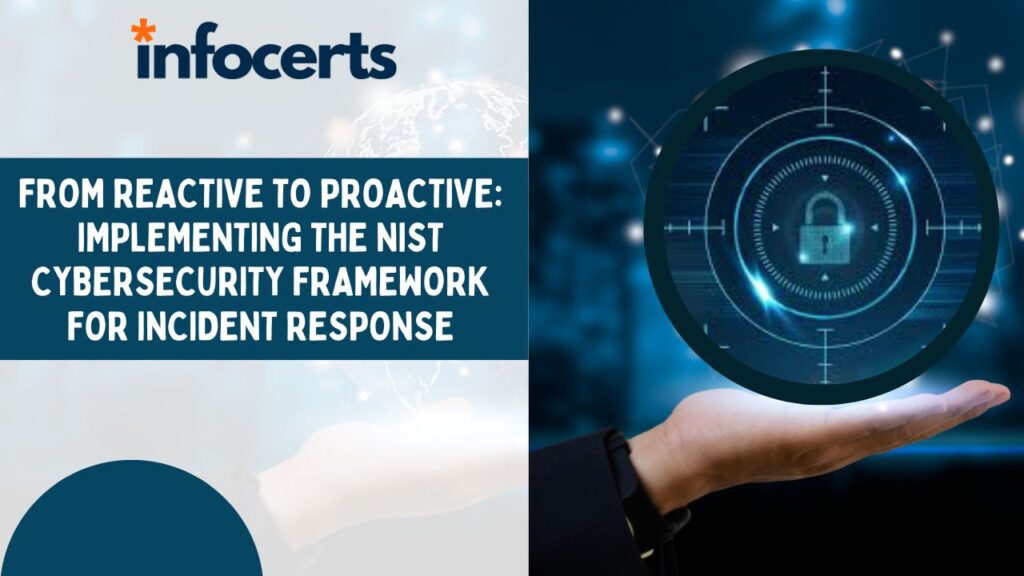Introduction: In today’s digital landscape, cyber threats are evolving rapidly, and organizations need to be prepared to mitigate potential risks. Reactive approaches to cybersecurity are no longer sufficient. It is imperative to shift towards proactive measures to ensure the security and resilience of our systems. One way to achieve this is by implementing the National Institute of Standards and Technology (NIST) Cybersecurity Framework for Incident Response. This framework provides a comprehensive and structured approach to effectively respond to cyber incidents. Let’s explore the key steps involved in transitioning from Reactive To Proactive Incident Response Implementation.
Step 1: Identify and Protect The first step is to identify and understand the assets, systems, and data that require protection. Conduct a thorough assessment of your organization’s infrastructure and classify assets based on their criticality. Implement robust access controls, network segmentation, and encryption mechanisms to safeguard sensitive information. Regularly update and patch software to eliminate vulnerabilities.
Step 2: Detect and Respond Establish an advanced threat detection system to promptly identify and respond to potential Security breaches. Monitor network traffic, implement intrusion detection and prevention systems, and deploy real-time security event monitoring. Develop an incident response plan that outlines roles, responsibilities, and communication channels for effective incident handling. Conduct periodic drills and simulations to test and refine your response capabilities.
Step 3: Recover and Learn In the aftermath of an incident, prioritize rapid recovery and restoration of normal operations. Regularly back up critical data and test the integrity of backups to ensure their reliability. Implement a robust incident management system to document and analyze incidents, identifying root causes and lessons learned. Use this information to improve security controls, update policies, and enhance staff training.
Step 4: Continuous Improvement Cybersecurity is an ongoing process. Regularly review and update your Proactive Incident Response Implementation plan based on emerging threats and changing business needs. Engage in threat intelligence sharing with industry peers and stay updated on the latest security best practices. Conduct periodic security assessments and audits to identify gaps and areas for improvement.
| Key Steps | Description |
| Identify and Protect | Conduct a comprehensive assessment of assets and systems, classify criticality, and implement access controls. |
| Example: Identify and classify sensitive data, such as customer information or intellectual property, and implement strict access controls and encryption mechanisms. | |
| Detect and Respond | Establish advanced threat detection systems, monitor network traffic, and develop an incident response plan. |
| Example: Deploy intrusion detection and prevention systems (IDPS), implement real-time security event monitoring, and define roles and responsibilities in the incident response plan. | |
| Recover and Learn | Prioritize rapid recovery, regularly back up critical data, and analyze incidents for root causes and lessons learned. |
| Example: Regularly back up critical data to offline or cloud storage, conduct post-incident reviews to identify vulnerabilities or weaknesses, and update incident response procedures accordingly. | |
| Continuous Improvement | Regularly review and update incident response plans, stay updated on threats, and conduct security assessments. |
| Example: Conduct periodic security assessments and audits, participate in threat intelligence sharing forums, and update incident response plans based on emerging threats and best practices. |
Conclusion: Transitioning from reactive to proactive incident response is crucial in the ever-evolving cybersecurity landscape. By implementing the NIST Cybersecurity Framework for Incident Response, organizations can enhance their resilience and effectively combat emerging threats. This framework provides a structured approach to identify, protect, detect, respond, recover, and continuously improve incident response capabilities. Investing in proactive incident response measures not only strengthens security but also fosters trust among stakeholders and helps safeguard the reputation of the organization. Embrace the NIST Cybersecurity Framework and take proactive steps to ensure your organization’s cyber resilience in the face of evolving threats.
FAQs
- What is the NIST Cybersecurity Framework for Incident Response?
- Why is transitioning from reactive to proactive incident response important?
- What are some key steps involved in implementing the NIST Cybersecurity Framework for Incident Response?
- How can organizations benefit from implementing the NIST Cybersecurity Framework for Incident Response?
- How can organizations keep up with evolving threats and ensure the effectiveness of their incident response capabilities?
——————————————————————————————————————–
Infocerts, 5B 306 Riverside Greens, Panvel, Raigad 410206 Maharashtra, India
Contact us – https://www.infocerts.com

